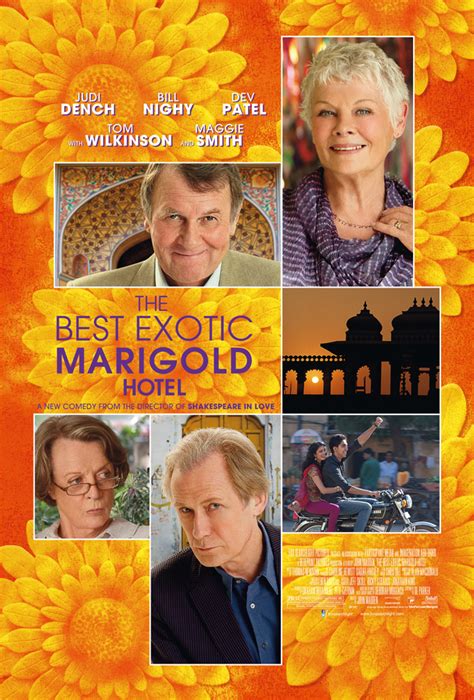The Best Exotic Marigold Hotel, a 2011 British comedy-drama film, has become a beloved classic among audiences worldwide. Directed by John Madden and written by Ol Parker, the movie follows a group of British retirees who decide to move to India, seeking a more affordable and fulfilling life. As they settle into the exotic Hotel Marigold, they discover that it’s not quite the luxurious paradise they were expecting, but rather a quirky and charming haven that transforms their lives in unexpected ways. Behind the scenes, the making of this film was just as fascinating as the story itself. Here are 10 film secrets of the Best Exotic Marigold Hotel revealed:
1. The Real-Life Inspiration
The idea for the film was inspired by Deborah Moggach’s 2004 novel “These Foolish Things.” The book explores themes of love, loss, and self-discovery among British retirees in India. The screenplay, however, took significant creative liberties to enhance the story, making it more cinematic and character-driven.
2. Casting Magic
The ensemble cast, including Judi Dench, Bill Nighy, Maggie Smith, and Tom Wilkinson, among others, was a deliberate choice to bring together some of Britain’s most esteemed actors. The cast’s chemistry was instant, and their performances were widely praised, contributing significantly to the film’s success.
3. Location, Location, Location
Although the story is set in India, some scenes were actually filmed in other locations due to logistical challenges. However, the bulk of the movie was shot on location in Rajasthan, India, with Udaipur serving as the primary backdrop for the exotic and picturesque settings. The choice of location added to the film’s vibrancy and authenticity.
4. The Hotel’s Real Identity
The Best Exotic Marigold Hotel itself is a character in the film, providing a unique and enchanting setting for the story to unfold. In reality, the hotel is a composite of several locations in Jaipur and Udaipur. The exterior shots were of the Ravla Khempur, a small boutique hotel in Rajasthan, while interior scenes were filmed in a studio or at other local hotels.
5. Cultural Sensitivity
The filmmakers were keenly aware of the need for cultural sensitivity, given the story’s setting and themes. They worked closely with Indian consultants and cast members to ensure that the portrayal of Indian culture was respectful and accurate. This included everything from the depiction of local customs to the nuances of character interactions.
6. Improvisation and Chemistry
While the script was tightly written, the actors were encouraged to improvise in certain scenes, which helped to create a more natural and spontaneous atmosphere. The cast’s real-life camaraderie and improvisational efforts significantly contributed to the film’s comedic moments and character depth.
7. Aging and Beauty
The film’s themes of aging, beauty, and the search for meaning in later life were deeply personal for some of the cast members. Judi Dench, for example, has spoken about how her character’s journey resonated with her own experiences and perspectives on aging, adding a layer of authenticity to her portrayal.
8. The Challenges of Filming in India
Filming in India presented unique challenges, from navigating complex bureaucracy to dealing with the practical realities of shooting in a bustling and sometimes unpredictable environment. The cast and crew often found themselves immersed in local life, with filming sometimes halted by passing processions or curious onlookers.
9. Music and Soundtrack
The film’s soundtrack, featuring a mix of Indian and Western music, was carefully curated to reflect the cultural blend and emotional journey of the characters. The score, composed by Thomas Newman, added depth and warmth to the film, complementing its vibrant visuals and performances.
10. Legacy and Impact
The Best Exotic Marigold Hotel was not only a commercial success but also spawned a sequel, “The Second Best Exotic Marigold Hotel,” in 2015. The film’s impact extends beyond the box office, as it helped to challenge stereotypes about aging and retirement, inspiring a new wave of films and stories focused on older characters and their life journeys.
In conclusion, the making of “The Best Exotic Marigold Hotel” is a story of creativity, cultural sensitivity, and the power of storytelling to inspire and transform. As we delve into the secrets behind this beloved film, we are reminded of the importance of authenticity, collaboration, and the pursuit of excellence in bringing a compelling story to life on the big screen.
What inspired the idea for “The Best Exotic Marigold Hotel”?
+The idea was inspired by Deborah Moggach’s novel “These Foolish Things,” which explores themes of love, loss, and self-discovery among British retirees in India.
Where was the film primarily shot?
+The film was primarily shot on location in Rajasthan, India, with Udaipur serving as the main backdrop for the exotic settings.
What was the approach to ensuring cultural sensitivity in the film?
+The filmmakers worked closely with Indian consultants and cast members to ensure that the portrayal of Indian culture was respectful and accurate, covering aspects from local customs to character interactions.



